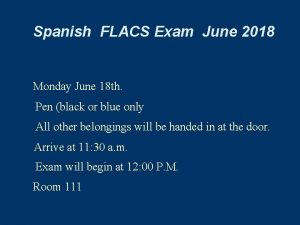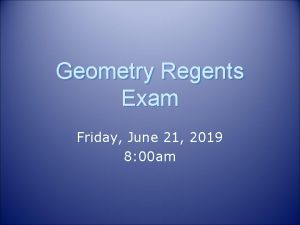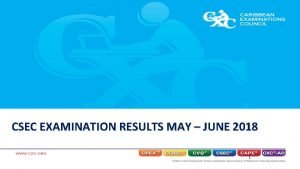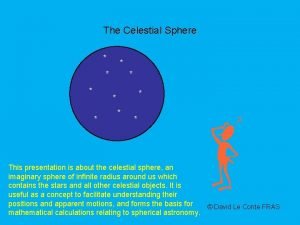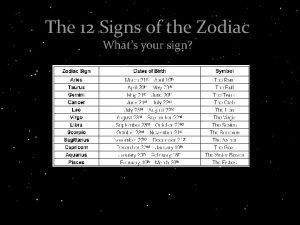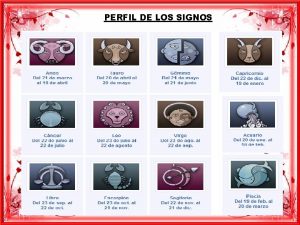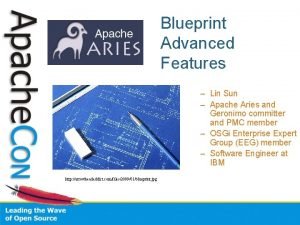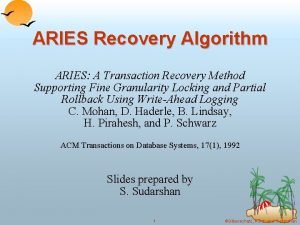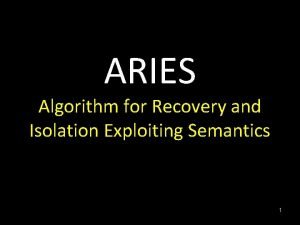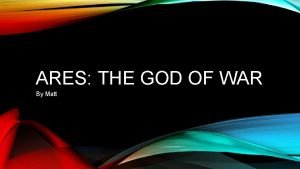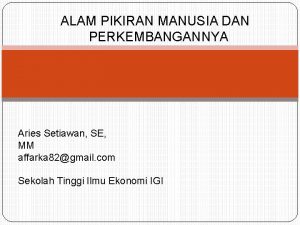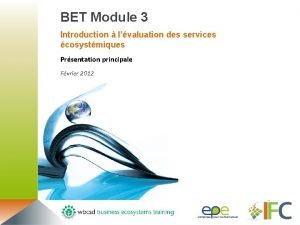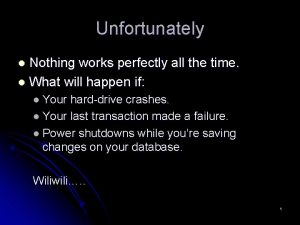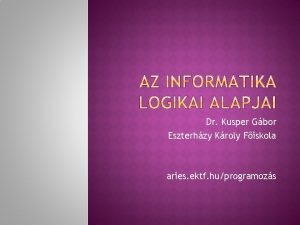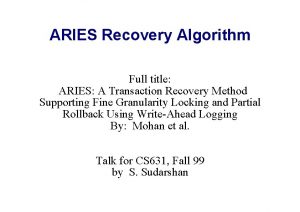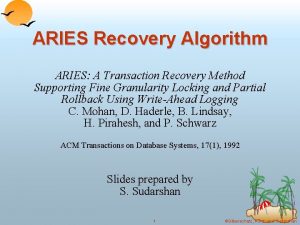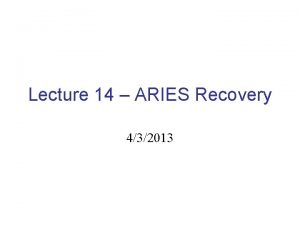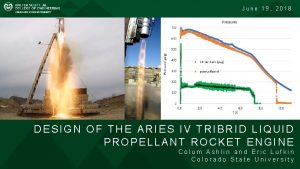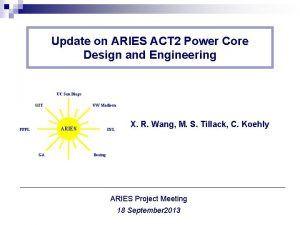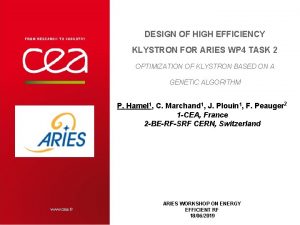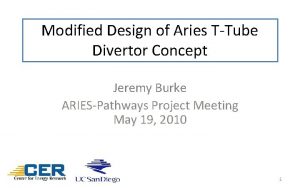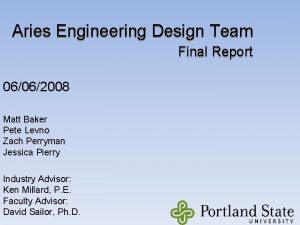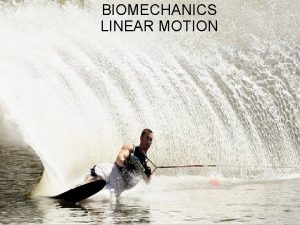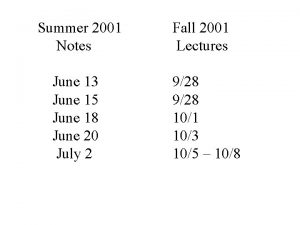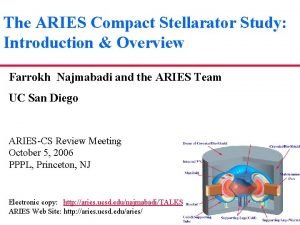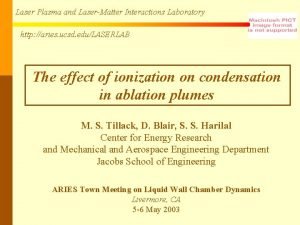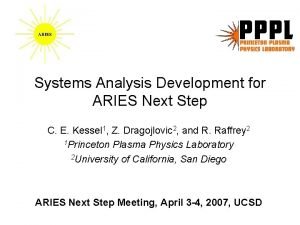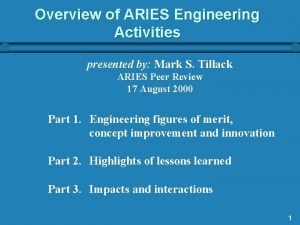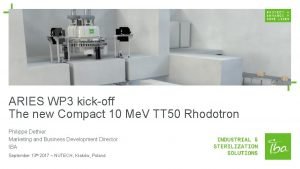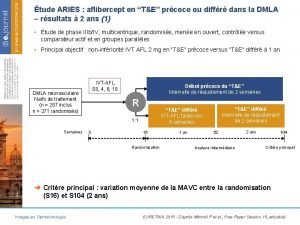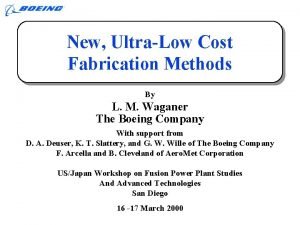June 19 2018 DESIGN OF THE ARIES IV

























- Slides: 25

June 19, 2018 DESIGN OF THE ARIES IV TRIBRID LIQUID PROPELLANT ROCKET ENGINE Colum Ashlin and Eric Lufkin Colorado State University

Introduction Design Summary Details of Design and Supporting Analysis Testing and Evaluation Conclusions and Recommendations CSU History in IREC Competition ARIES I (2015) – The team designed and built a nitrous oxide/HTPB hybrid powered rocket and were awarded the Gil Moore Technology Innovation Award. ARIES II (2016) – The team improved the hybrid rocket engine with the use of aluminum/HTPB/nitrous oxide and improved the airframe construction. ARIES III (2017) – The team designed and built a LIQUID ethanol/nitrous oxide engine, added grid fins to the design and greatly improved the airframe. ARIES IV (2018) – The team has refined the liquid rocket engine and included an active control system to control the apogee. 2

Introduction Design Summary Details of Design and Supporting Analysis Testing and Evaluation Conclusions and Recommendations ARIES I (2015) and ARIES II (2016) Solid Fuel Grain Graphite Nozzle Injector Plate Preheater Grain Oxidizer Tank Fitting Oxidizer Tank Vent Tube Drogue Parachute Electronics/ Payload Bays Main Parachute 3 CSU ARIES I and II teams successfully designed, built, launched and recovered hybrid rocket in their first two years in the competition

Introduction Design Summary Details of Design and Supporting Analysis Testing and Evaluation Conclusions and Recommendations ARIES II - 2016 4

Introduction Design Summary ARIES III (2017) Details of Design and Supporting Analysis Testing and Evaluation Conclusions and Recommendations CSU ARIES III team successfully designed, built and launched liquid propellant N 2 O/C 2 H 5 OH rocket. 5

Introduction Design Summary Details of Design and Supporting Analysis Testing and Evaluation Conclusions and Recommendations ARIES III (2017) 6

Introduction Design Summary ARIES III (2017) Details of Design and Supporting Analysis Testing and Evaluation Conclusions and Recommendations CSU ARIES III N 2 O/C 2 H 5 OH rocket catastrophically failed 1 second into flight. 7

Introduction Design Summary Details of Design and Supporting Analysis Testing and Evaluation Conclusions and Recommendations ARIES IV – 2018 Mission: Improve upon the Aries III design by separating tanks, developing a new injector with better mixing, and developing mathematical models to better predict performance • Successfully developed small scale engine. Allowed for full systems testing at a fraction of the cost of full scale testing. • Successfully developed robust mathematical model of rocket trajectory, as well as a model that accurately predicts discharge time of propellants. • Unsuccessfully, then successfully developed a liquid engine capable of taking the Aries IV to 10000 ft. 8

Introduction Design Summary Details of Design and Supporting Analysis Testing and Evaluation Conclusions and Recommendations Design Summary Overview Major Design Innovations: ● Separation of propellant tanks and combustion chamber ● Custom slide check valves ● Pintle Injector 9

Introduction Design Summary Details of Design and Supporting Analysis Testing and Evaluation Conclusions and Recommendations Design Summary Tribrid Liquid Propellant Engine 10

Introduction Design Summary Details of Design and Supporting Analysis Testing and Evaluation Conclusions and Recommendations Design Summary Tank/Chamber Separation 11

Introduction Design Summary Details of Design and Supporting Analysis Testing and Evaluation Conclusions and Recommendations Design Summary Slide Check Valves 12

Introduction Design Summary Details of Design and Supporting Analysis Testing and Evaluation Conclusions and Recommendations Design Summary Pintle Injector 13

Introduction Design Summary Details of Design and Supporting Analysis Testing and Evaluation Conclusions and Recommendations Design Summary Ignition Process 14

Introduction Design Summary Details of Design and Supporting Analysis Testing and Evaluation Conclusions and Recommendations Testing and Evaluation Full ethanol combustion Hybrid mode (depleted ethanol) 15

Failure Analysis • • • The propellant built up in the combustion chamber and a hard start was achieved. The nozzle was also designed to allow for a high combustion chamber pressure, which prevented the exhaust from leaving easily. The entire team worked together to cut weight from the rocket so the mass flow could be reduced and the combustion chamber could operate at a lower pressure. The propellant tanks were shortened to the minimum size necessary to take an optimized rocket to 10, 000 ft. The combustion chamber was shortened to prevent propellant build up and reduce rocket mass. The mass flow was significantly reduced and the throat area of the nozzle was increased.

Introduction Design Summary Details of Design and Supporting Analysis Testing and Evaluation Conclusions and Recommendations Experimental Results from Static Test Fires Chamber Pressure, Thrust, Nitrous Tank Pressure, Ethanol Tank Pressure, Average Propellant Mass Flow Rate 17

Introduction Design Summary Details of Design and Supporting Analysis Testing and Evaluation Conclusions and Recommendations Experimental Results from Static Test Fires Used to Refine Rocket Engine Model C*, Thrust Coefficient, Injector Discharge Coefficients 18

Introduction Design Summary Details of Design and Supporting Analysis Testing and Evaluation Conclusions and Recommendations Thermodynamic Liquid Rocket Engine Model Static 19

Introduction Design Summary Details of Design and Supporting Analysis Testing and Evaluation Conclusions and Recommendations Thermodynamic Liquid Rocket Engine Model Dynamic 20

Introduction Design Summary Details of Design and Supporting Analysis Testing and Evaluation Conclusions and Recommendations Ignition Transient and Combustion Stability Quasi-steady engine/tank models accurately predict steady chamber pressure and thrust vs. time, but we currently lack the ability to predict transient chamber pressure at ignition and pressure pulsations due to “chugging”. Ignition Transient Pressure Pulsations 140 Hz (50 psi peak-peak; 140 Hz) 21

Introduction Design Summary Details of Design and Supporting Analysis Testing and Evaluation Conclusions and Recommendations Testing and Evaluation Range Impulse (lb*s) C* efficiency (s) Thrust (lbs) 3500 -4000* 90 -93% 480 -520 *Hybrid mode included ● ● Total impulse needs to be met to reach apogee C* efficiency is measured to see how well the system is performing 22

Introduction Design Summary Details of Design and Supporting Analysis Testing and Evaluation Conclusions and Recommendations • Manufactured well within budget constraints Stock 1866. 82 Tooling 242. 84 Testing Hardware 326. 96 Engine Components Consumables Left To Spend 693. 6 1119. 02 1007. 76 23

Introduction Design Summary Details of Design and Supporting Analysis Testing and Evaluation Conclusions and Recommendations • Understand every subsystem necessary for the engine to perform, as well as all identified failure modes • Get started manufacturing and doing subsystem tests early. It takes longer than you think • Have more members on the propulsion team • Take the system that’s been designed and built this year, and scale it up to take Aries V to 30, 000 feet (or beyond) • Begin experimenting with kerosene and maybe LOX • Try for a full scale launch prior to the competition 24

Questions? 25
 Flax exam
Flax exam June 21 2019 geometry regents answers
June 21 2019 geometry regents answers Flacs checkpoint b spanish exam june 2016 answers
Flacs checkpoint b spanish exam june 2016 answers Cxc 2018 results
Cxc 2018 results January 2009 chemistry regents answers
January 2009 chemistry regents answers B a f c j e
B a f c j e Introduction to aries
Introduction to aries Ensow
Ensow Leo strengths and weaknesses
Leo strengths and weaknesses Compatibilidad entre picis y tauro
Compatibilidad entre picis y tauro Transilvania it cluster
Transilvania it cluster Aries blueprint
Aries blueprint Aries recovery algorithm
Aries recovery algorithm Opie childhood sociology
Opie childhood sociology Lindsey bleimes
Lindsey bleimes Algorithm for recovery and isolation exploiting semantics
Algorithm for recovery and isolation exploiting semantics Ares symbols greek mythology
Ares symbols greek mythology Aries nature
Aries nature Aries 1960
Aries 1960 Aries producciones existe
Aries producciones existe Aries bcsd
Aries bcsd I'm an aries
I'm an aries Que odia aries
Que odia aries Astros aries
Astros aries Aries magyarul
Aries magyarul Horscopo
Horscopo
